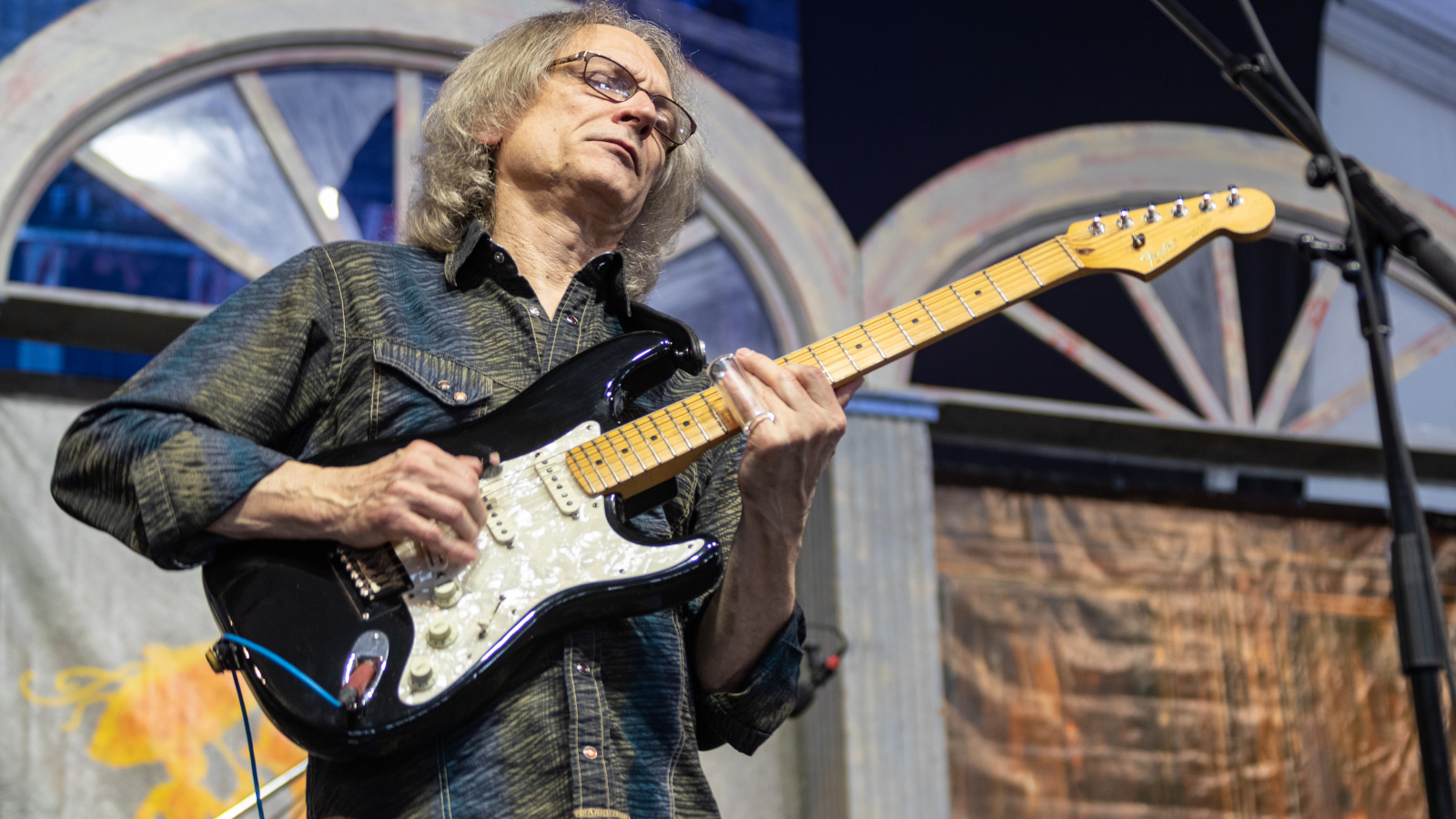
“Playing the guitar is a life-long pursuit and a joy,” says slide guitar legend Sonny Landreth. “You can always learn something from another player because the art of guitar playing is so personal. What one player takes from somebody else gets interpreted in a new way, and then you pick up the thread and do it your way. In that respect, it never gets old or boring.”
You can always learn something from another player because the art of guitar playing is so personal
Sonny Landreth
Between recording sessions and tours, Landreth puts the guitar down to catch his breath, but he stresses that he has a three-day max for downtime.
“I feel like I’m at my best when I keep my edge up,” he says. “It’s like what athletes goes through – they have to let their body rest. But after three days, I’ll look at the guitar and it’ll be like, ‘Okay, what have you done for me lately?’
“At that point, I have to go to it and get my chops going. But it’s fun. Before long, I’m flying again.”
Here, Landreth runs down his tips for slide guitarists of all levels of experience.

1. Have a Dedicated Guitar Set up for Slide
“I’ve never found any type of guitar that couldn’t be converted for slide playing. I used to go to music stores and pick up different guitars, and I’d play slide on them – no big deal. But it helps to have a dedicated guitar that you use only for slide because there are various issues you need to address, which I’ll touch on.
“So the bottom line is, yes, you can play slide on anything, but in order to make that back-and-forth transition from a standard guitar to a slide guitar easier, especially when you’re using other tunings, pick one guitar, maybe with a higher nut, and make that your slide instrument.”
All the latest guitar news, interviews, lessons, reviews, deals and more, direct to your inbox!
2. Start With an E Tuning
“There are many different tunings you can use – and I love all of them – but I recommend starting with E. Low to high, that’s E, B, E, G#, B, E. The reason why I suggest starting with this tuning is because it gives you some familiar real estate with some strings you already know in standard tuning.
“As with all chordal tunings, it will open up a new world of possibilities with sympathetic strings and harmonics that will give you a more complex sound. Once you slide up into a big E chord at the 12th fret, you’re in the game.”

3. Try Heavier Gauge Strings
“The extra tension of a heavier gauge will increase your string height, and that will really improve your sustain. It will also reduce the rattle and choke you’ll have to contend with when the action is too low with light-gauge strings that are too close to the fretboard.
“Let’s face it: Putting a piece of glass, metal or whatever you use for a slide on a finger to play the guitar is usually a strange, awkward affair at first. Beefing up your string gauge can help to ease you into place.”
4. Find the Happy Couple
“Match the size and weight of your slide with your string gauge. There is no one combination that is best for everyone, so it’ll take a bit of experimentation. You want a slide that isn’t so heavy that it chokes out on thinner strings, but isn’t so light that you don’t get enough sustain with thicker strings.
“There’s a universe of different options out there – glass, metal, porcelain to name a few – all of which are worthy of consideration. You can always change up later, but first go with what resonates with you and feels the most like home.”

5. Learn to Pick Fingerstyle
“I started on fingerpicking when I was in my teens. I saw another kid doing it, and it blew my mind. I spent a whole summer teaching myself fingerstyle. You can navigate a lot more territory and with better control by fingerpicking. For me, this results in a more tactile playing experience.
“To employ string guarding with your picking hand, each finger and your thumb should rest on the strings not being used at any given moment. This will make a huge difference for better articulation and cleaning up your chops.
“With your slide hand, lay one or more of the fingers you’re not using across the strings and gently drag them along for the ride to mute unwanted noise. When you get this move down, learn to alternate between muting and lifting those fingers to include some of the quirky overtones and odd sounds to spice things up.”
6. Improve Your Intonation With This Cool Trick
“Using only the index finger of your slide hand, play a note on the fretboard and then stop. Next, using your slide, go up on that string and suspend the same pitch. Now compare the two. Are you nailing the pitch with your slide? If not, no worries – just keep at it.
“Make the same kind of comparison by picking or chiming an open string and then sliding to an octave higher at the 12th fret to hone your ear and tighten up accuracy. You’ll get it. Patience is paramount.”

7. Vibrato Like a Leslie Cabinet
“I’ve always had a thing for the sound of a real Hammond B3 organ going through a Leslie cabinet. George Harrison did that on some Beatles songs, and he went through a Leslie. Eric Clapton, too – a lot of the British guys did. I thought, How can I get that sound without a Leslie cabinet?
“Well, here’s a way: Practice your vibrato at different rates of speed as if you’re switching a rotary speaker on and off. With these changes of intensity, you can rule the mood from laid-back to wide open and all points in between.”
8. Practice With a Click or Metronome
“The goal is to hone your timing so that you’re neither a runaway train nor the one who missed the party. You want to improve your accuracy so that you’re consistently locked in with each downbeat until it becomes second nature. Then you can experiment by playing some things slightly ahead of the beat and some slightly behind.
“With faster passages, it’ll sound like you’re excited about what you’re doing, which isn’t a bad thing. On the slower passages, if you’re a bit behind, you can stretch out certain passages and melodic lines, and it’ll sound more soulful and expressive.”

9. Double Your Mojo – On Acoustic
“Alternate your slide work between electric and acoustic with the same techniques and tunings. It’s a great feeling to reinterpret a piece you normally play on electric guitar with an acoustic guitar, and vice versa. It’ll spark new ideas and breathe new life into your songs.
“This also applies to a non-slide guitar. Your sustain will be very different on an acoustic than on an electric, so you have to work more, particularly when you’re between notes. But it’s a cool way to play, and you should try it.”
10. Become the Horn Section
“Because wind instrument players have to take breaths throughout a piece, there’s a natural sort of conversational quality to their phrasing. Try emulating this effect by sliding quickly into the first note of a solo, and then give the last note of each phrase a longer, silkier slide down.
“Pause like you’re taking a breath and then alternate from long to short for the next line. Mix things up and improvise. It’ll make things a lot more interesting, and it will help your instrument sing.”
Browse the Sonny Landreth catalog here.

Joe is a freelance journalist who has, over the past few decades, interviewed hundreds of guitarists for Guitar World, Guitar Player, MusicRadar and Classic Rock. He is also a former editor of Guitar World, contributing writer for Guitar Aficionado and VP of A&R for Island Records. He’s an enthusiastic guitarist, but he’s nowhere near the likes of the people he interviews. Surprisingly, his skills are more suited to the drums. If you need a drummer for your Beatles tribute band, look him up.
